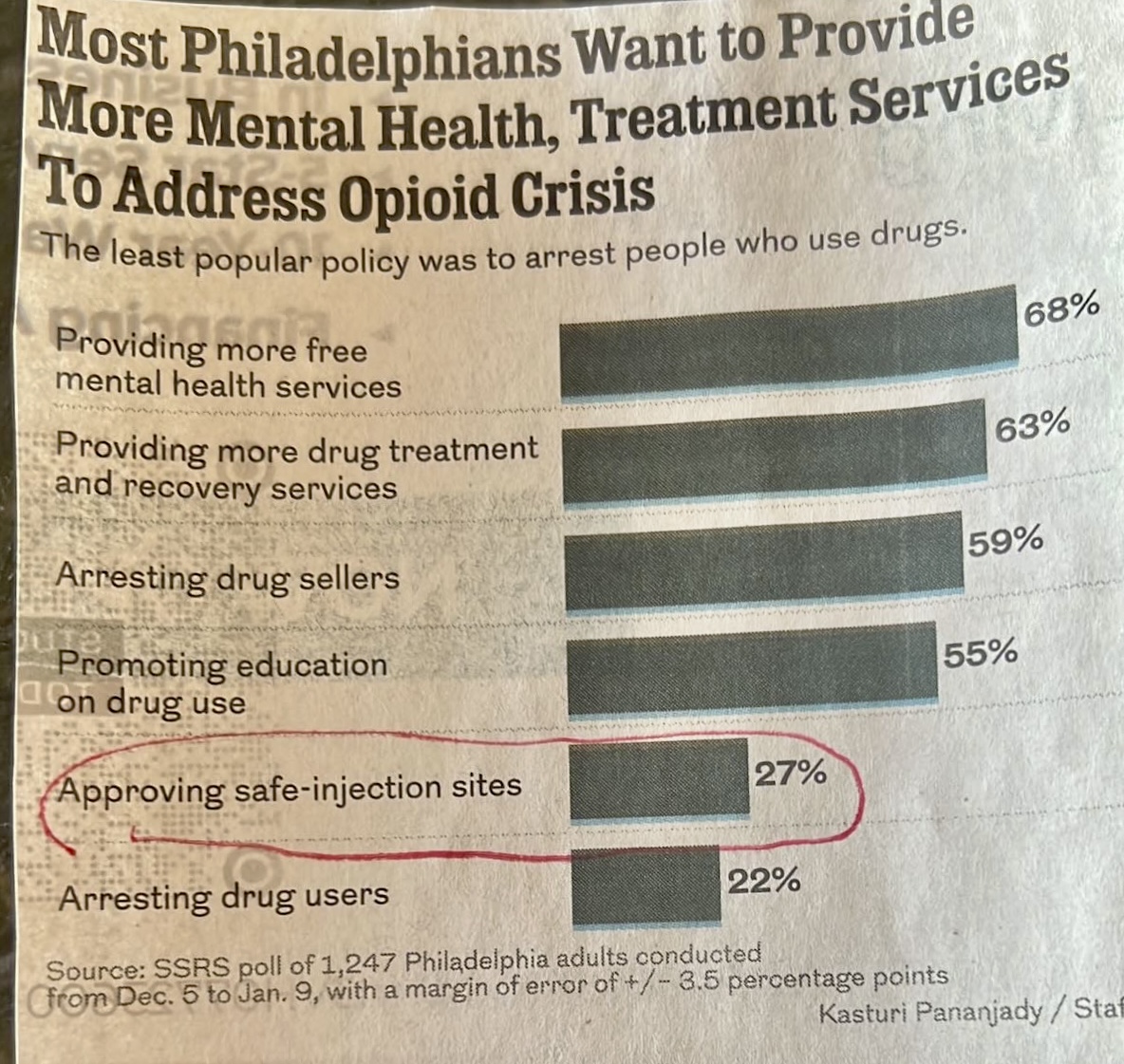“Safe injection” sites are not safe, nor wanted
I’m not going to say the majority is always right. There is sufficient evidence to show that is incorrect.

Still, elected officials are put in office to represent the wishes of the majority of those who elected them, with some limited exceptions -- such as wanting measures that violate the Constitution.
That is not the case with so-called “safe injection” sites, which are not safe (which is why the geniuses pushing them now call them “harm reduction” centers.)
In a poll conducted by the Lenfast Institute for Journalism, my main takeaway is that only 27% of those surveyed approve of “safe injection” sites. The other 73% are not heartless, but they smell a rat.
In its headline, the Philadelphia Inquirer chose to say Philadelphians “reject using war-on-drugs era policies.”
The Inquirer did not say what policies were “war on drugs,” but it’s a safe bet that would mean law enforcement.
Or, more accurately, no law enforcement.
But the polling reveals the opposite.
When it comes to drug dealers, a solid majority of 59% say they should be arrested.
Only 22% believe drug users should be arrested, preferring to send them to treatment.
The thorn in the treatment bouquet is this: What if the addicts don’t want to go to treatment to get clean?
In the poll, a huge majority of 68% want more free mental health services, closely followed by 63% wanting more drug treatment and recovery services.
Wishing is nice but it won’t pay the bills. Where to get the money from? Here: Confiscation of drugs sellers’ property -- cash, weapons, cars, homes. This can be controversial, but it can be successfully done. It may not pay for everything, but it is a start, as would be long prison sentences for dealing, because dealing destroys lives and causes deaths. Note to D.A. Larry Krasner: Drug dealing is not a victimless crime.
The city tried to sneak a “safe injection” site into South Philly in 2020, but it was repulsed by neighbors.
Rumor has it the happy band of Mayor Jim Kenney’s progressive rat pack is plotting another attack and neighbors smell that rat pack. There was a meeting last Tuesday at the U.S. Attorney's office, to which some community representatives were invited, but elected officials were barred, according to District 6 Councilman Mike Driscoll, who would have liked to attend.
A source at the U.S. Attorney's office confirmed the meeting, which was described as a "listening session" to community members, and about a dozen attended.
Here's the key: The previous U.S. Attorney, Bill McSwain, sued Safehouse, which promulgates the “safe injection” sites. McSwain believed the operation violated federal law and was, in effect, a drug house. The new U.S. Attorney, Jacqueline Romero, was appointed by President Joe Biden last June and neighbors suspect her outlook is different.
Community leaders requested a meeting to make sure their concerns would be heard by Romero, who is seeking a settlement with Safehouse.
1st Dictrict Councilman Mark Squilla, who was barred from the meeting, said neighbors told him they smelled a rat. Squilla told me Kenney’s wet dream is to have several “safe injection” outlets in several neighborhoods. To share the pain, I guess. In any event, Sequilla said he was told the decision about dropping the law suit would be made by the Department of Justice in Washington, where the rats would be insulated from their decision.
To answer my question about how to get the addicts to treatment: Using illegal drugs is a criminal offense. Give them a choice between jail (where they can get clean going cold turkey) or a rehab hospital, where they can be weaned off drugs slowly.
Each case is designed to end addiction.
“Safe injection” sites are designed to prolong addiction.
Do you want to end addiction or continue it? 73% say end it.
Will the city and DOJ listen or will this -- with the help of Joe Biden's appointee -- be Kenney’s final, destructive legacy?



